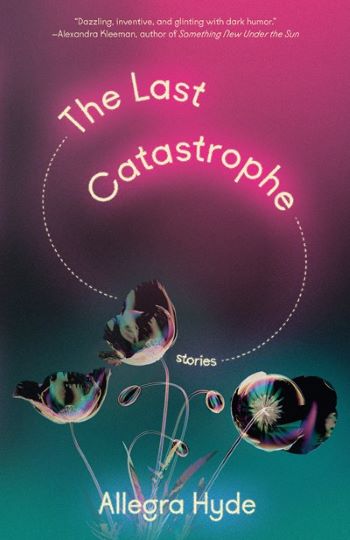[ad_1]
For all the ominousness of the title, The Last Catastrophe, Allegra Hyde’s sophomore short story collection, is remarkably hopeful. Not hopeful as to the eventual collapse of ecosystems, or the extinction of species, or technology addiction, or pollution, or the state of American politics (though Hyde’s satire on this front is biting enough to be, if not hopeful, quite funny) but hopeful as to the human capacity to find joy in spite of it all. Sometimes, as a particle scientist explains in one of Hyde’s stories, pollution makes sunsets more intense, more beautiful. The paradox of finding something decent—or, at the very least, something essentially human—amidst all the terrors and general badness lying in wait for the inhabitants of our planet is at the heart of Hyde’s collection.
The stories in The Last Catastrophe are mostly speculative and set in an array of not-so-distant, gloomy futures. In one of the early stories, “The Tough Part,” only five moose remain in the entire world, and a bickering couple, urged onward by their four-year-old daughter, unite in an attempt to save them. Fast forward a few pages to the couple wandering around the countryside, each occupying one half of a tick-ridden moose costume, swerving through swimming pools and eighteen-wheelers to try to lead the dwindling handful of remaining moose to Canada, which they imagine to be a safe, wild place. The plan is equal parts fatalistic, silly, and wrenching. Because even though such a place may not exist (and deep down, we understand it does not) what exactly is the alternative? We may either give up or keep going. Hyde wants us to keep going.
Hyde turns her focus to technology in “The Future Is a Click Away.” Here, data-driven retail takes the form of the Algorithm, which sends people products in anticipation of their needs. The Algorithm sends electrolyte-filled coconut water to help with a hangover, baby clothes before a baby is born, and air purifiers for wildfire smoke. When the onslaught of supposedly helpful products stretch budgets too thin, people accommodate in other ways, by foregoing summer camp for the kids or skipping softball league to work more. In the American tradition, rampant consumption temporarily staves off the dread of existing in an increasingly volatile and eroding world until you go bankrupt anyway.
If the premises sound depressing, they are. If they sound real enough to believe, real enough that by reading them you might conceive of such a future, they are that, too. While The Last Catastrophe is a brilliant collection from many angles, Hyde particularly excels in one notoriously difficult way: making the amorphous and incomprehensible aspects of climate change and its effects feel tangibly real.
The climate crisis, unfortunately for activists and everyone else who inhabits this planet, can be simultaneously unfathomable and more than a bit boring in the technical details of how many degrees Celsius the temperature can rise before we’re all done for. Fortunately for readers, The Last Catastrophe is neither unfathomable nor boring. Quite the opposite. The stories proceed jauntily and are each so captivating that by the time you reach the last story—“The Eaters,” which, at over fifty pages, qualifies as a novella—you’re even a little sad it isn’t longer.
While The Last Catastrophe is not weighed down by sluggish lists of facts on sea level changes and wind patterns, those facts are all in there, inherent in the premises. Hyde’s meticulous research is evident in the way the science blends seamlessly into the background. These details–the increase in the severity of weather events; the intensification of volatility, both environmental and political; the decline in access to water, food, and any other resource necessary to human survival–are just the backdrop. We know these things. And in reading The Last Catastrophe, we see a few different versions of how we might act. We understand the stakes. We can imagine how the losses might feel. We can acknowledge, as one character in “The Eaters” does, that “to see the last something—be it a zoo-kept koala or a human community—is a privilege. A horrific privilege, but a privilege nonetheless.”
In The Last Catastrophe, people will continue to be people, come wildfire or high water, or any other of the many forms of climate catastrophe. And people are funny. When faced with unfathomable doom, we are unable to believe that the worst is actually happening. Unable to conceptualize our own demise, we revert to what we know.
In “The Eaters,” a barrage of ravenous beings who were genetically modified to consume grass in an effort to solve the global hunger crisis wait at the gate of one of the few surviving compounds inhabited by living humans. These hungry former-people (still-people?), the Eaters, are poised to break through the gates and devour the compound’s food supply, along with, perhaps, its inhabitants. It’s a dire situation. The scene plays out through the perspectives of a biogas technician turned temporary president of the compound, a sixteen-year-old who talks to her stuffed animal, and a former professor of Mesopotamian history. Though their lives are in peril, the characters fret over whether something they said is embarrassing or how to appear attractive to a potential mate. In the bleakest scenarios, humans act remarkably like ourselves.
Hyde also captures the American political vernacular unsettlingly well. You know it—the bootstrapping, thoughts and prayers, we’re more alike than we are different blather that’s meant to unite us all in vague enough terms that we don’t take too close a look at what exactly we’re being gathered to cheer for. In “Democracy in America,” the president’s boorish entreaties for unity go beyond the metaphorical: he quite literally advocates for bulldozing all the Great Lakes to form One Big Lake. It’s absurd. Isn’t it? Like many successful works of satire, the absurdity and reality blend closely enough to make you squint.
The Last Catastrophe is divided into three parts, and the stories within the last third of the book pack an especially strong emotional punch. They expose the astonishing inanity of empty entreaties to “my fellow Americans” for unity when set within a class system that has always been and will continue to be unequal. Such exposure is particularly sobering when set within a scenario bleak enough that there are no more “fellow Americans.” There are only survivors. For instance, in “Colonel Merryweather’s Intergalactic Finishing School for Young Ladies of Grace & Good Nature,” the very wealthiest people have escaped a doomed planet (leaving everyone else to die) and travel through space in a mothership decades later. The mothership houses a finishing school meant to train girls to be supportive and reassuring wives while the men search for a new place to live, Earth no longer inhabitable. Like many of the other stories in the collection, it is punctuated by humor, but this time, the ending is gutting. It’s funny until it’s not. We think we can believe the direness of climate catastrophe now, but we can’t, not really, not when we have the ability to order anything we could ever want to our doorsteps in time for dinner.
But Hyde believes we can try. The tough part is trying, but there are so many things worth saving.

FICTION
by Allegra Hyde
Vintage
Published on March 28, 2023

[ad_2]
Source link

